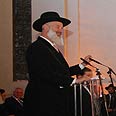
Hungary's oldest synagogue reopens
Budapest shul reinstated decades after being seized from Jews. 'This is a joyful occasion not only for Jews, but for everyone,' says Hungarian deputy PM
Thousands of Hungarian Jews participated this week in a ceremonial reopening of the country's oldest synagogue, which was previously expropriated from the Jewish community.
The structure has undergone massive renovations in recent months, estimated to have cost over $500,000. Israel's Chief Rabbi Yona Metzger and Hungarian Deputy Prime Minister Zsolt Semjen were in attendance.
As part of the ceremonial preparations, police closed off all streets bordering the synagogue due to concerns of anti-Semitic-related attacks. Dozens of policeman surrounded the synagogue square, where an orchestra played Jewish melodies.
Following the brief opening greetings and ribbon-cutting ceremony, a chupah (Jewish wedding canopy) was placed inside the synagogue, under which the primary donor Gábor Futó carried in the first Torah scroll, completed earlier that day.
_gal.jpg)
Metzger and Futó carry new Torah scroll (Photo: Robert Vamos)
Rabbi Yona Metzger then delivered a speech, saying that "this synagogue is located in this part of the city because 200 hundred years ago, the local government prohibited Jews from residing in other parts of the city, and we are now witness to the government's unreserved support of the Jewish community. This is the closing of an important circle."
Hungary's deputy PM said in his speech that "a house of prayer, whatever religion, is the connection between man and God. Every person has a natural need to connect with the creator and when his house of prayer is taken away so is his ability to have this connection. The reopening of this synagogue is therefore a joyful occasion, not just for the Jews, but for every human being."
Rabbi Aryeh Goldberg, deputy director of the Rabbinical Centre of Europe, related to the timing of the opening ceremony: "We will all stand and pray during the Jewish New Year, not just for ourselves and not just for the Jewish people, but for all humanity, including the Hungarian government and people."
One of the most emotional moments at the opening ceremony was when a resident of Budapest and Holocaust survivor, who lived in an orphanage adjacent to the synagogue during World War II (when it was still active), lit candles commemorating those who prayed there but did not live to see its restoration.
- Follow Ynetnews on Facebook










